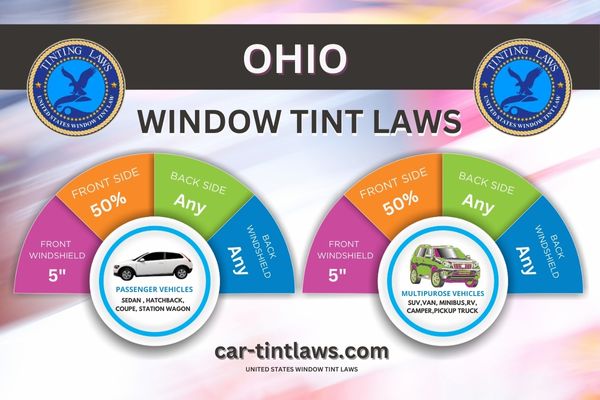Did you know that in Ohio, front side windows on sedans must allow more than 50% of light to pass through?
This regulation, along with others, aims to balance driver visibility and privacy.
With varying rules for SUVs and vans, understanding how these laws impact your vehicle’s compliance is important.
Moreover, Ohio provides medical exemptions for those needing darker tints, but proper documentation is necessary.
Violating these laws could lead to fines and additional costs. Curious about how these rules apply to your car or what specific requirements you must follow?
Window Tint Darkness in Ohio
In Ohio, the rules for window tint darkness differ based on the type of vehicle and the specific windows being tinted.
For sedans, the front side windows must allow more than 50% of light in, while the back side and rear windows can have any level of darkness.
SUVs and vans follow similar regulations, with the same light allowance for front side windows and no restrictions on the back side and rear windows.
Tint darkness for sedans:
- Windshield: Non-reflective tint is allowed on the top 5 inches of the windshield.
- Front Side windows: Must allow more than 50% of light in.
- Back Side windows: No specific requirement.
- Rear Window: No specific requirement.
Tint darkness for SUV and Vans:
- Windshield: Only non-reflective tint is permitted on the top 5 inches
- Front Side windows: Must allow more than 50% of light in
- Back Side windows: Any darkness of tint is allowed
- Rear window: Any darkness of tint is allowed
Window Tint Reflection in Ohio
When considering tint reflection for sedans, SUVs, and vans, Ohio law is quite specific.
You’re prohibited from using reflectorized materials on front and back side windows, which means the amount of light reflected by the tint must be minimal.
This regulation guarantees that both your visibility and that of other drivers aren’t compromised by excess glare.
Tint reflection for sedans:
- Front Side windows: Must not be more than 20% reflective.
- Back Side windows: Must not be more than 20% reflective.
Tint reflection for SUV and vans:
- Front Side windows: Reflective materials are strictly prohibited.
- Back Side windows: Reflective materials are strictly prohibited.
Other Ohio window tint rules and regulations
- Medical Exceptions: Ohio allows medical exemptions for darker tints with proper documentation.
- Penalties: Violating tinting laws in Ohio can result in a ticket.

Medical Exemptions for Window Tint Rules in Ohio
If you have a medical condition that necessitates darker window tint, Ohio grants exemptions with proper documentation from a licensed physician or optometrist.
These medical exemptions provide an important flexibility in the window tint regulations for those who need it for health reasons.
To qualify for an exemption, you must present proper documentation that supports the medical necessity for a darker tint.
This documentation should clearly state the specific physical condition that warrants the need for increased tinting.
It’s important to make sure that the information comes from a licensed professional, as this is essential for the exemption to be valid.
Medical exemptions are aimed at accommodating individuals with conditions such as photosensitivity, lupus, or other health issues that make exposure to sunlight harmful.
By allowing these exceptions, Ohio law recognizes the significance of catering to health needs while maintaining overall road safety.
Ohio Window Tint Ticket Cost
While medical exemptions offer some flexibility, it’s important to comprehend the costs and consequences associated with violating Ohio’s window tint laws.
If you’re caught with an illegal tint on your vehicle, you could face fines ranging from $100 to $150. These fines can add up, especially if you’re a repeat offender.
The Ohio window tint law is strict, and adhering to it is essential to avoid these unnecessary expenses.
In addition to the immediate financial burden of a window tint ticket cost, there are other legal consequences to take into account.
Beyond the fines, you may be required to remove the illegal tint from your vehicle.
This often involves additional costs, both for the removal process and for any subsequent inspection fees to ensure your vehicle complies with state regulations.
Understanding Ohio window tint laws can help you avoid these costly tickets. If you have a valid medical exemption, make sure you have proper documentation to present to authorities.
This will help you stay within legal limits and prevent any fines or legal repercussions.
Staying informed and compliant with these laws strengthens your sense of community and responsibility as a driver in Ohio.
Ohio Vehicle Registration Details
When registering your vehicle in Ohio, you’ll need to provide proof of insurance and a valid driver’s license.
The fees for registration vary depending on your vehicle’s type, weight, and the county where you reside.
Renewal notices are sent by mail or email based on your preference, and it’s important to keep these details updated to avoid fines and penalties.
Registration Renewal Process
Every year, Ohio vehicle owners must update their registration through the BMV.
Whether your vehicle features window tint film that allows a certain level of Visible Light Transmission or has tinted side windows, you must still complete this annual process.
The Ohio BMV sends out renewal notices approximately 45 days before your registration is set to expire, giving you ample time to prepare.
You can opt to update your registration online, by mail, or in person at your local BMV office.
It’s a straightforward process and Ohio offers multiple convenient options to accommodate your schedule.
Keep in mind that updating on time is essential, as late fees will be applied if you miss the expiration date.
When you receive your renewal notice, make sure to check if proof of insurance and an emissions test are required for your specific vehicle.
These documents guarantee that your car meets Ohio’s safety and environmental standards.
Completing these steps beforehand will help you avoid any delays.
Required Documentation
To register your vehicle in Ohio, you’ll need to provide proof of ownership, a valid ID, and proof of insurance.
The proof of ownership can be a title, lease agreement, or another official document that confirms you are the rightful owner of the vehicle.
A valid identification, such as your driver’s license, is also important.
You must present proof of insurance that meets Ohio’s minimum coverage requirements to confirm you’re covered in case of an accident.
Ohio law enforcement requires these documents to verify that your vehicle is legally registered and that you comply with state regulations, including those related to window tinting.
Proper documentation is essential for avoiding legal issues and making sure that your vehicle meets all safety standards.
Additionally, your vehicle must pass an inspection to confirm its roadworthiness before registration renewal.
When you gather these documents, make sure they are current and accurate.
This preparation helps streamline the registration process and minimizes the chance of delays.
Remember, maintaining your vehicle’s registration is not only about compliance; it’s about ensuring that you, your loved ones, and others on the road are safe.
Fees and Fines
After collecting the necessary documentation for registering your vehicle, it’s equally important to be mindful of the fees and fines associated with violating Ohio’s window tinting laws.
Ohio’s window tint laws are strict, and not following them can lead to significant penalties.
If you are found in violation of these laws, you could face fines ranging from $100 to $1,000.
It is vital to understand that law enforcement officers can issue citations for illegal window tint during routine traffic stops.
Repeated violations may result in even steeper penalties. If you are a repeat offender, you could face higher fines and the potential for license suspension.
This highlights the importance of ensuring that your vehicle’s window tint complies with Ohio regulations to avoid these severe consequences.
References
Ohio Revised Code Section 4513.241: Using tinted glass and other vision obscuring materials
Frequently Asked Questions
What Is the Darkest Legal Tint in Ohio?
You can have the darkest tint on your back and rear windows with no limits. For safety, front side windows must allow 50% light.
Remember, violating tint regulations can lead to fines. Exemptions exist for medical conditions.
Can You Get Pulled Over for 5% Tint in Ohio?
Yes, you can get pulled over for 5% tint in Ohio. Law enforcement prioritizes tint enforcement due to safety concerns.
The extreme tint darkness affects visibility, leading to potential legalities. You might need tint removal to comply.
How Do I Get a Window Tint Exemption in Ohio?
If you’re fighting sunlight like a knight against dragons, you’ll need a medical exemption.
Start the exemption process by submitting required documentation from a doctor about your medical conditions.
This lets you adjust your tint percentage legally.
How Much Is a Window Tint Ticket in Ohio?
A window tint ticket in Ohio can cost you between $100 and $150.
Enforcement policies depend on your tint percentage and its impact on visibility.
Multiple violations increase fines, so it’s essential to comply with the regulations.
Conclusion
Understanding Ohio’s window tinting laws is essential for compliance and avoiding fines.
It is worth mentioning that over 30% of vehicles fail initial inspections due to improper tinting.
By making sure that the front side windows of your sedan allow more than 50% light in and avoiding reflective materials on SUVs and vans, you can stay within the law.
Keep in mind that medical exemptions are available with proper documentation.
Following these guidelines will help you avoid penalties and extra expenses.
